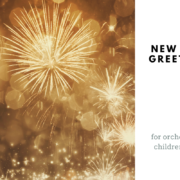New Year Greetings
Original title: Évköszöntő
For orchestra and children’s choir, commissioned by the Hungarian State Opera.
duration: approx. 11 min.
ORCHESTRA
Flute
Flute/Piccolo
2Oboe
Clarinet in Sib
Clarinet in Sib/1Bass Clarinet in Sib
2Bassoons
Contrabassoon
4Horns in Fa
2Trumpets in C
3Trombones
Timpani (G, A, B, Bb)
Drums (Bass Drum, Timbale 14″, Glockenspiel, Cymbal, Suspended Cymbal, Triangle,
Tambourine, Tom-toms, Wood block)
Children’s Choir
Strings
Lyrics:
Adjon Isten minden jót
Ez új esztendőben:
Jobb üdőt, mint tavaly volt,
Ez új esztendőben;
Jó tavaszt, őszt, telet, nyárt,
Jó termést és jó vásárt
Ez új esztendőben;
Adjon Isten minden jót
Ez új esztendőben:
Zsíros esőt, kövér hót,
Ez új esztendőben;
Bő aratást, szüretet,
Egészséget, jó kedvet
Ez új esztendőben!
Adjon Isten minden jót
Ez új esztendőben:
Drága jó bort, olcsó sót
Ez új esztendőben;
Jó kenyeret, szalonnát
Tizenkét hónapon át
Ez új esztendőben!
Adjon Isten minden jót
Ez új esztendőben:
Vegye el mind a nem jót,
Ez új esztendőben;
Mitől félünk, mentsen meg,
Amit várunk, legyen meg,
Ez új esztendőben!
Rough translation:
May God grant us all the best
In this new year:
Better wheather than last year
In this new year;
Good spring, automn, winter, summer,
Good harvest and good market
In this new year;
May God grant us all the best
In this new year:
Gross rain, fat snow
In this new year;
Rich harvest, vintage,
Health, good mood
In this new year!
May God grant us all the best
In this new year:
Expencive good wine, cheep salt
In this new year;
Good bread, bacon
For twelve mounthes
In this new year!
May God grant us all the best
In this new year:
Tahe away all the bads
In this new year;
From all that we fear, may God save us,
Let it be what we’re waitng for,
In this new year!

